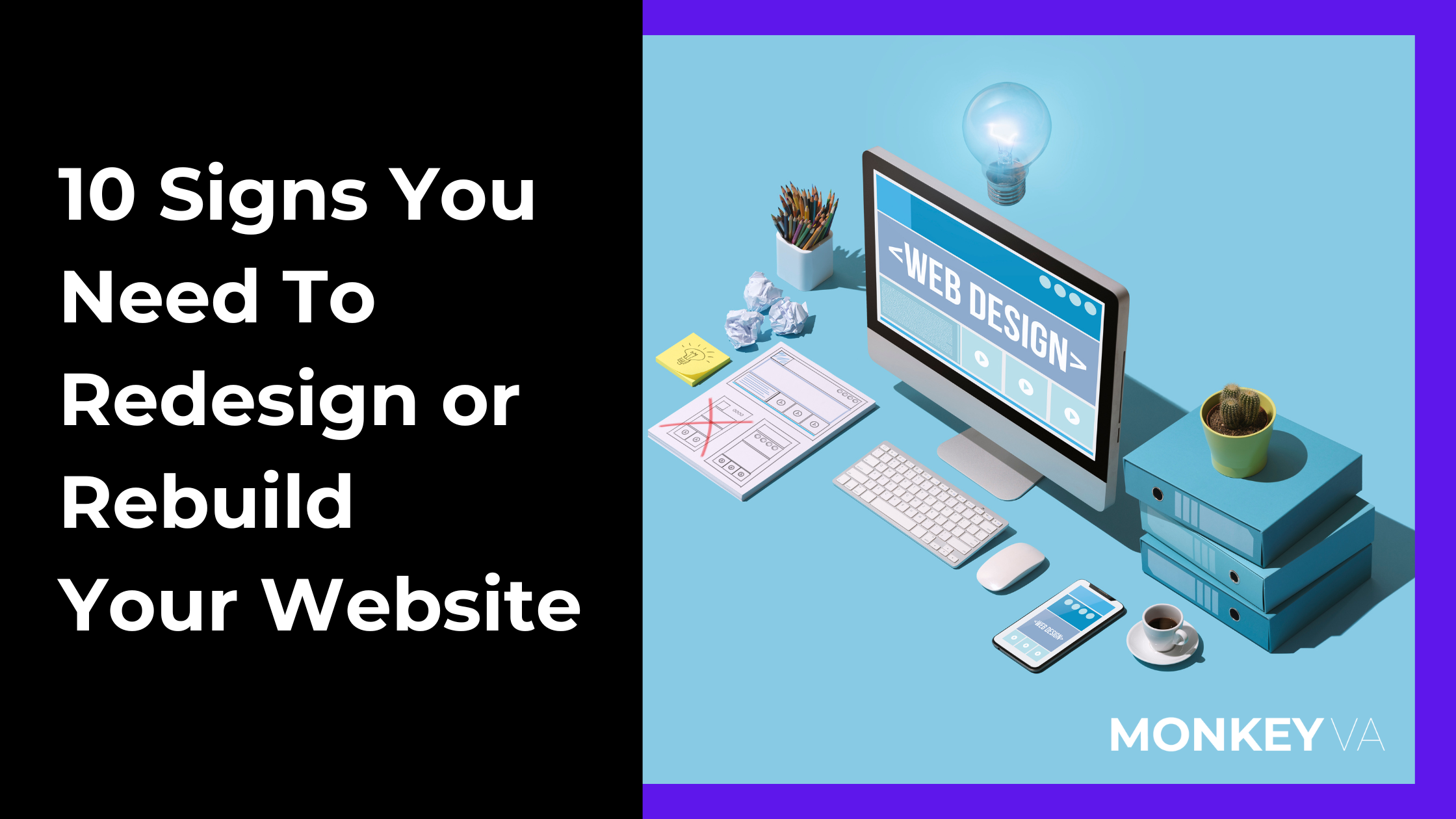The decision to redesign or rebuild your website should be made with functionality and customer experience as your priority.
Table of Contents
Your website is the face of your business. It needs to be welcoming, informative, and credible to build your customer base and boost your revenue.
Even if your social media marketing is working wonders to bring viewers to your site, a poorly designed web page will fail to convert those visitors into customers.
In addition to regularly maintaining your website, there are times when you may need to go further. We’ve compiled 10 warning signs that tell you when you need to redesign or rebuild your website.
But first, let’s go into what it means to redesign or rebuild your website, and why each type of update matters.
Should You Redesign or Rebuild Your Website?
Imagine your website is a house. Maybe your house is in decent condition with good plumbing, heating, and wiring, but the wallpaper is unappealing and some of the amenities are getting old.
In this case, you are redesigning: there’s no need to mess with the foundations—you can repaint rooms and replace utilities without having to tear much up. Some things might be a little more complicated or time-consuming, and you might have to call in an expert, but these adjustments don’t change the basic structure. For your website, this might mean changing the look of your web pages, cleaning up your links and navigation, and making sure your visuals are operating properly.
But if your house is moldy, heavily damaged, or its foundations, heating, and wiring aren’t up to code, you might have to really dig down and rebuild things from the ground up. This means looking at your HTML and scripts, your hosting servers and domain control, and your Content Management Systems.
Rebuilding is usually more intensive than redesigning, so you don’t want to start from scratch if all you need is a new coat of paint. We’ll start with the signs that indicate you might need a redesign before going into the ones that warn you’ll need to rebuild. Understanding whether you need to redesign or rebuild your website—and understanding the difference between a rebuild and a redesign—will be a matter of identifying your site’s biggest needs.
Five Signs You Need to Redesign Your Website
1. You have recently changed your branding
If you’ve decided to take your brand in a new direction, you’ll want to redesign your website to match. It’s never a good idea to put off updating your website or else your audience will be confused: if your name, logo, or designs are inconsistent, they might think they’ve got the wrong website. Either way, it looks unprofessional.
Communicate your vision with your design team to make sure that everything is updated on a clear timeline. Match updates and redesigns with public announcements to make sure you retain your audience as those new changes start rolling in.
2. Your traffic rate is steady, but the conversion rate is wavering
If your website is generating decent traffic, but you aren’t getting any conversions, there’s a good chance something is up with your design.
That incoming traffic means that your marketing strategies are paying off: people are clicking links on your social media and search results are returning your website. But a low or dropping conversion rate means there’s nothing on your website that is convincing those visitors they want to become customers.
This is a major sign to watch out for if you haven’t had any major changes to your strategy or services which could be impacting your conversion rate.
3. It is difficult to navigate to the information you need
Elegant user experience design can be more of an art than a science. For a very long time, many designers held to the “three-click rule” which said visitors were likely to become frustrated if they had to click more than three times to do anything on a website.
Now, with e-commerce and blogs built into business websites, it can be useful to help visitors browse through a lot of content. Instead of focusing on “three clicks” it’s important to think about user progress: every click should feel meaningful and informative, like a step towards a goal.
Look at how your content is organized. Do your tags and categories make sense? Does your content match the page header? Are you attaching hyperlinks to text that is informative? Are the pages too crowded with sidebars and headers to find your way around?
If your website isn’t driving conversion, focus on updating the quality of your pages’ content and design, not just the quantity of clicks or links.
4. There are dead links and useless pages
Linking to outdated articles and websites comes with a high risk of linkrot: links that don’t go anywhere because the pages they lead to are no longer active. This can impact even the most professional websites over time: even the New York Times struggles with dead links.
It’s important to focus on updated and reliable sources when linking to outside websites because they are less likely to be taken down. Working links leading to relevant information make your website look professional and up-to-date. It also improves your security, lowering the chance you might link to an unknown website that’s built on a repurposed domain.
Check your internal links as well. If you have a “coming soon!” page for a project that hasn’t seen any progress in a year, you should take it down. The same goes for those out-of-date mailing list forms, pages about retired services or blog posts that aren’t relevant to your current brand.
5. Visual elements don’t work on mobile browsers
Nearly half of all web traffic in the United States comes from mobile phones. If your website isn’t properly formatted for mobile browsers, your conversion rate will suffer.
Nobody wants to spend time trying to navigate an improperly formatted website where the images don’t fit the screen or the text is crowded into the margins. At the very least, your website should be mobile-friendly, which be accomplished with a simple re-design. In the long run, you should plan to redesign your website to be fully mobile-optimized.
On their own, these five signs only require redesigns to be addressed, but you might run into more serious issues while you try to implement your solutions. These next five signs might indicate that you need to rebuild your website.
Five Signs You Need to Rebuild Your Website
1. It is difficult to add or edit pages on your website
If you keep running into technical errors when you want to upload a blog post or edit an old page, it might be a sign that you need to reconsider your current Content Management System (CMS).
A CMS is a platform to compose, edit, and publish content on your website. Some popular examples include WordPress and Joomla.
Quality Content Management Systems should make your workflow more consistent, reduce the technical coding required to update your content, and offer plugins for extended functionality.
If your current system is an obstacle to your workflow and requires constant technical support, it might be time to rebuild your website with a CMS that better fits your needs.
2. You can’t implement the functions you need
Videos are refusing to load or play? Users can’t fill out forms? It’s impossible to implement a working comments section?
If a single feature isn’t working, that might be a design problem. If you cannot find a way to implement a required function with repeated attempts, you probably need to go deeper into the way your website is built to solve the problem.
This might be something that can be solved by changing to a CMS with the functionality that you need already built-in. It may also require updating your scripts and checking your HTML.
3. Your CMS has no support or updates
The Internet can often feel like a stable, permanent place, but the tools used to manage websites evolve very fast. Programming languages and software that fail to update will soon become redundant, and CMS platforms are no different.
While it might feel convenient to stick with a platform that doesn’t change, no updates and no tech support is never worth the risk. If you run into one issue that you can’t solve on your own, you’re pretty much stuck. What’s more, no updates will eventually make your website look outdated, lacking the functionality of your competition.
4. Your website is noticeably slow
If you can tell that your website is slowing down to a crawl, and nothing is wrong with your internet connection, you’re probably using outdated or poorly implemented code on your website.
Use a speed tester like tools.pingdom.com or a page rater like Google’s Core Web Vitals to see if your site is running properly. If any pages are underperforming, it’s time to plan a rebuild.
5. The cost of maintaining your website is going up
Keep an eye on your budget: are you spending more and more to keep your website running without any improvement in functionality or conversion? It might be time to rebuild your website using a more affordable CMS or look for services with better tools.
High quality maintenance and hosting services can be expensive, but effective CMS platforms and maintenance should keep your website running smoothly at a reasonable, fixed rate. Paying to fix emergencies and crashes should be the exception, not the rule.
Choosing to Redesign or Rebuild Your Website
With these ten signs, you can identify when your website needs a new look or requires intensive reconstruction and new design tools. If you’re still unsure which to choose, or are in need of a website revamp checklist or website redesign strategy, check out all the resources that we offer.



